Squatter Imaginaries
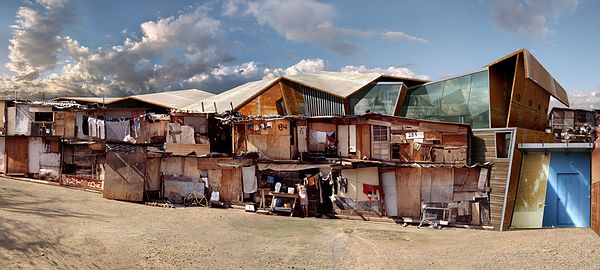
One of the most intriguing facets of Dionisio Gonzalez's photographic constructions is that they immediately question the viewer's knowledge of what a "slum" actually looks like and what are the political forces that shape slums. To that end, he asks us if "slum" is even an appropriate term at all. Viewers less familiar with these spaces may not detect the careful nuances of his work and instead simply digest these as neither appropriate nor inappropriate images of global poverty, but rather as ones that are simply real.
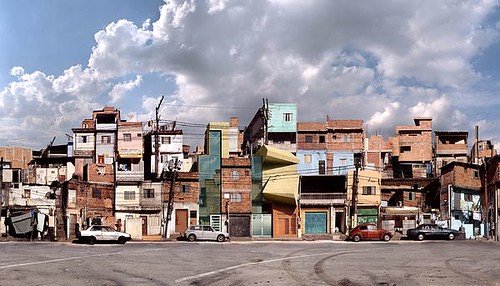
In my opinion, what is most important about any work of art is the actual effect it will have on culture and public perception. In this case, we are forced to ask what messages about squatter communities are being transmitted through these images? How are we supposed to view them in the first place? Despite the way they may look to us, how is it that those from the outside want to view these images in some way, and digest them as accurate portraits of squatter settlements? More importantly, how does one even responsibly represent global poverty anyway? It's a delicate subject and we need to be mindful whenever a representation like this is asserted for any group, especially one as politically charged as global poverty.
Gonzalez's depictions of the favela in Brazil are daring and clever and not only evoke a sensibility about how places of urban poverty can be seen as humane but ultimately captures an image of the contradictory landscape that lurks within these sites as well. In this sense, he not only shows us how extreme poverty looks but also how its landscape is politically produced – how spaces of poverty are formed from the inside. Through a kind of architectural ambiguity he shows us the organizational conflicts that squatters wrestle with in their struggle to survive, exposing tensions of being caught between the unnoticed accomplishments of their own self-assembly and of being re-imaged by some formal outside intervention that seeks to restore a certain order to their perceived chaos.

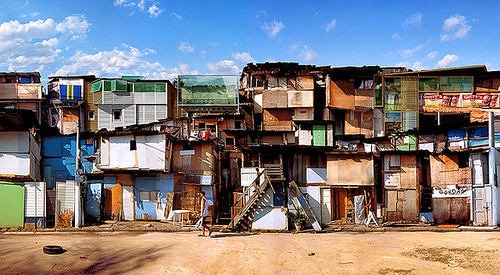
Given this conflict I think his images bring a dignity to the lexicon of visual references that commonly creates a public awareness (or a lack thereof) around these informal settlements and that have – for the most part – been defined by the media's dismal portrayal of global poverty. It seems like the media is always focusing on them in the wake of some disaster, a flood, a fire, or only as the evidence that human squalor does indeed still exist. Rarely does it seem the shanty is shown to us in light of its own exceptional operability, its vivacious culture - instead these elements may only be used to angle some sort of slumaphobia or slumsploitation of a kind of othered world poverty chic.
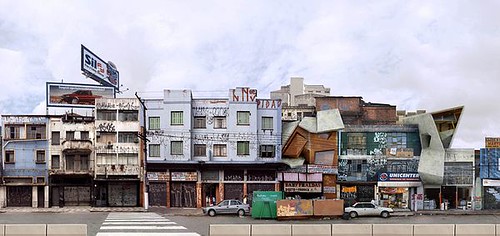
On one hand, we see the favela here as a colorful and humanized, somewhat un-depressed space of habitability in Gonzalez's eye – there is a sense despite the hyper-density that some spatial pressure has been relieved from the favela by its own doing, which runs counter to the typical collective imaginary of seeing shack dwellers as savages heaped in an insurmountable pile of urban depravity and debris. While, on the other hand, I'm not sure if his images actually alight a sense of social responsibility in the viewer in the way I think they are intended, or whether they unconsciously - and against their own will - reinforce this "civilizing" perspective of the favela as a place where spatial order needs to be imposed.
Viewing these images alone without any additional story or knowledge of Gonzalez's craft or explanation there is an undercurrent of two worlds fusing together in what almost casts a raw glimpse of the world's urban future where the continued global mixing of the Developed and Developing worlds begins to clash and architecturally blur, break down and ultimately reconstruct itself into something else looking like this. In fact "squatters" already constitute the largest single source of homebuilders worldwide today.

In this image (that almost assumes a tourist postcard perspective, ironically enough) the chaotic informality of the shacks suddenly rests upon one another in columns of a new kind of visual order. The sprawling totality of the unbridled favela is suddenly somehow geometrically grasped now, while in reality the spaces of the favela easily slip through our perspective's fingers as they are arranged by an unpredictable meandering of gaps and temporary walls, and a more or less incomprehensible maze-like logic of spatial circulation. We might say, in their very lack of formal planning, that the favlea is unwittingly designed to resist any sense of conformity to our organizational understanding – to our westernized viewing of them. However some of Gonzalez's renditions arrange the favela within a kind of logic of reform that is not altogether idealistic but is more discernible this way and confronts us with the question of whether the favela can even be rationalized or not.

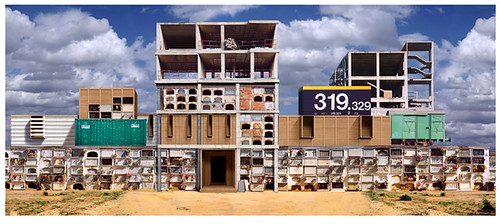
In viewing these images we can't be sure if the blend of scrap structures and more formal design elements are in overall harmony with the squats, or whether they are altogether entrenched in some sort of deeper disorganizational conflict. Are these subtle designs exerting any power over the settlement? Are these clean and modern signs of gentrification appropriate in any way, or simply ignorant of what is miraculously being improvised by the squatters on their own? Is Gonzalez suggesting that so-called globalization in this context translates to a modernized strategy for refining the typology of poverty and reshaping it into a more civilized image? Or, are these architectural interventions actually helping to buttress the vitality and natural evolution of the favela itself? The politics of space are absolutely critical to our own understanding of how spaces of poverty are not only produced but how they may be treated – and even how they may be seen.
Further toying with this ambiguity, his images provoke a realization that while the Third world is being threatened by creeping forms of gentrification a part of the "civilized" world is also being overcome by the scrappy rash of what we might call a Third Worldization. That is to say, even though we are definitively looking at the Brazilian favela there is an implication that the favela is also moving into these other urban sites of global wealth abroad. Somewhere therein the role of the architect is mediated. Essentially, as I read these images, Gonzalez is questioning whether architects and planners are merely adding to the spatial divides of global poverty and wealth, or whether there is a deeper humanitarian role for them to assume where they may be able to make a positive impact towards improving the conditions of the favela without re-imaging it. We must question, however, whether the ambiguity in these images suggests a positive interweaving of these worlds or whether it is the disguise for a more subtle bordering within them.

We might just as easily read these images as complexions of the spatial-ordering of global capital that is super-imposed onto places of informal settlement by architects and planners. Either way, the question of the architect's role is an astute reflection on Gonzalez's part because in actual practice this is a critical realm of engagement for the architect who seeks to address the sites of global poverty without giving into to a remaking of them – and I think Gonzalez's work brilliantly negotiates the sensitive nature of that terrain. Of course, another interpretation here is that the shack dwellers have managed to pioneer new uses of these foreign materials themselves and to some degree already represent the new breed of global architects today.
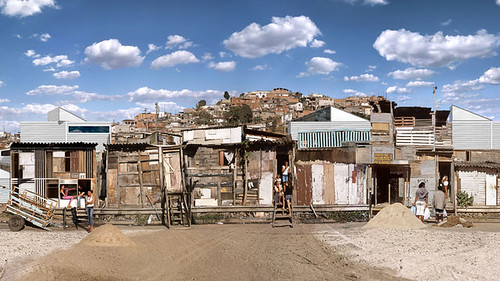
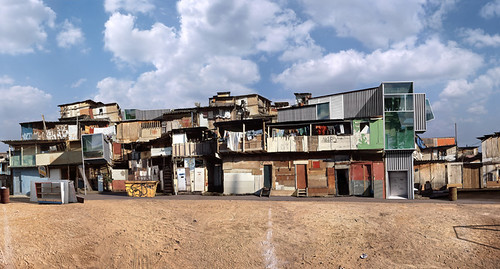
I think however we see these images if we examine them collectively it is clear that all of these issues are illustrated in them together offering perhaps a page-by-page un-layering of the internal/external overlap of the favela's urban archeology, where the intrinsicality of the favela collides with the outside projection of it, where politics are inherently cast in the structures of the favela as well as reinvented by some outside re-imagination of them. At the core, these images are about the favela's struggle to construct it own identity.
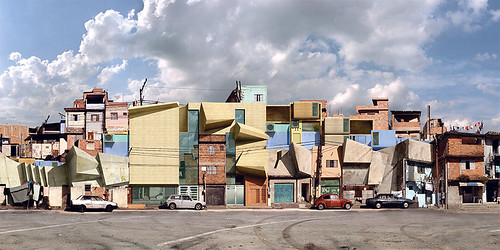
In a recent interview Gonzalez did for ZOOM magazine he mentioned how some of the most important urban renewal strategies in Brazil have failed due to the prevailing attitude that the shack dwellers "should be prescribed some kind of morality" through the state’s provision of replacement housing, and that "those invisible to the system should finally be cataloged" by it. He cites the Cingapura Project ("Brazil's most important shantytown re-urbanization and verticalization program") as a massive flop of an intervention because it unfurled no plan that was at all in accordance with the favela context itself, it neglected the favela-dwellers entirely by not ever discussing the project with them, and ultimately revealed itself to be an indexing structure for those laborers who were "invisible" and needed to be officially logged into the government's bureaucracy. His insights into the ways the disrespectful reform doctrine of the government’s re-urbanization planning are spatialized through these mega-housing projects are cogent and amazingly documented through these images. Gonzalez said much of his work is motivated to both make evident the less visible political landscape that dehumanizes the favela by re-imagining it through these types of "proletarian parks of verticalized operative housing" projects (as he calls them), and to help visualize an architectural alternative that can go with the favela and that will preserve what he refers to as a "symbolic de-categorization of their inhabitants."

[Image: Real Parque Favela's Cingapuras (via).]
One thing I find ironic about these billion dollar re-housing programs is that often times they are stated as a means to defeat the organized crime that operates within the favelas, yet the favelas themselves are also deemed these labyrinthine spaces of utter chaos. It's interesting to me that for a place that could be seen as so unorganized that the government believes their only scheme to defeat the "organized crime" of the favela is to re-organize the neighborhood physically to one that it horizontally ordered and fashioned according to the principles of official organizational planning.
In addition, Rob points out on his blog that even the well-oiled machine that is allegedly looking out for the squatters' best interests are not always completely in touch with what that may actually be.. This he illustrated in light of a recent $10m donation from the Gates Foundation to Slum Dwellers International (SDI) who's been found intimidating certain groups of squatters into joining their coalition.
Rob wisely writes, "SDI should note that with money and success comes responsibility to be inclusive. SDI tends to only work with groups that embrace it's own 'savings-plan' version of organizing. But there are many communities that don't see saving money as the best organizing tool, particularly if they are facing immanent eviction. SDI now has an opportunity to broaden its vision and its reach."
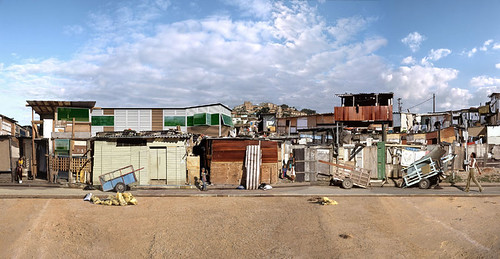
Another thing Gonzalez mentioned in the ZOOM interview was that it's not always that photographers get to propose architectural solutions. And as a non-architect myself I can relate to his inspiration here. Somewhere in his structural ambiguity he has not only I think envisioned a vibrant squatter-led future into urban salvage, but has helped us to see more clearly all of the complex layers of representation that go into both the (un)making and the simultaneous viewing of the sites and shanties of global poverty. Even more so, his images conjure the possibility of spaces still to come. That is, I view these images as both critical and constructively radical; in a constant state of becoming (like the shanty) they piece themselves together through perpetual transition, progressing, resisting, rooting themselves into their own place of being, architecting their own political future. When it's sometimes easier to just iterate the problem with an elegant critique, Gonzalez goes further to convey an alternative born of the shantytown, his own version of a re-urbanization plan using the fabric of the favela itself. In short, he portrays the favela as continuing to pioneer its own destiny, shape its own space. And quite honestly, I think his images are a brilliant visual re-constitution of what I’ve called a ‘squatter urbanism’ and - needless to say - I can't stop obsessing over them.
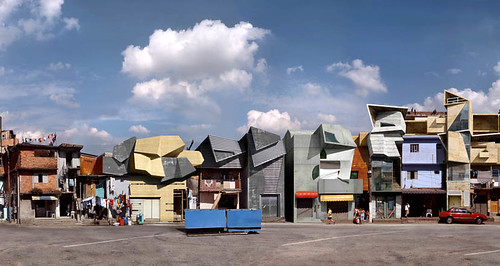
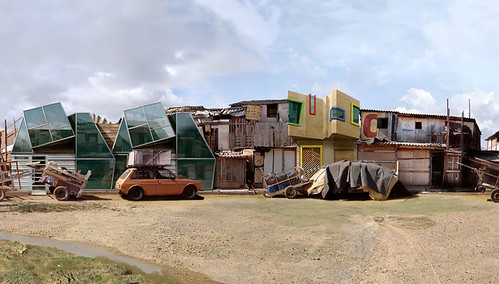
Be that as it may, I am also cautious (as I am reminded in the Flint piece) of obsessing over the image too far in a way that keeps detached from the more complex landscape behind it. No matter how we try to acknowledge this I realize I am not immune to falling into my own innocent love affair with an aestheticization of the image. Because in the end, even the images themselves play into their own kind of political imaginary, one that can be, as I've said, inadvertently complicit with the tropes that continue to dictate how poverty is viewed from afar, and so perhaps we also need to be willing to accept the more commonly overlooked perspective which is that – despite our best intentions and political conscience – it may be more useful in some ways to just let the squatter communities represent themselves.
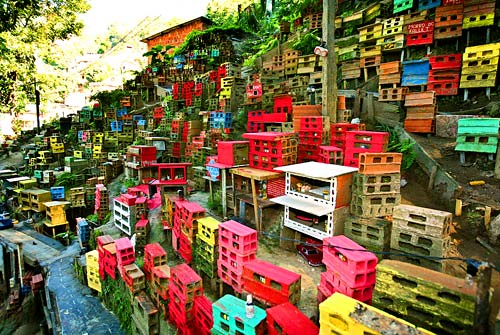
[Image: The Morrinho Project, from the LA Times, From the streets of Brazil, 2007, photo by Wania Corredo.]
On that tip, I am reminded of the Morrinho Project out of the Rio favela, Villa Pereira da Silva, better known as Pereirão. Regine covered this a while back, telling us that back in 1998, "kids built up a miniature reproduction of their favela (Pereirão, perched above the upper class Laranjeiras neighbourhood) using bricks and other materials left-over from building their own house. The model covers 300 square meters, and is inhabited by scavenged toys (plastic cars, little figurines carrying AK-47s or a ball, etc.) which are used to re-create scenes of everyday life in a favela: from dance events to clashes between gang members." She goes on to quote from an article that explained just how true-to-life this model was. So much in fact, that the police thought it was being used to help create a kind of favela war-plan and forced the kids to tear it down. Since then the model has gained a lot of attention and portions of it have traveled around the world and been reassembled in various art exhibitions, namely the Venice Biennale.
What I find most compelling about the project, which has since spawned its own independent TV production studio and guided educational tours of the neighborhood, while continuing to circulate the model in exhibitions, is the fact that it all started from this basic desire to build a replica of the community. And what an amazing job those kids did, too. Seriously. I mean, I am so curious of the process, what they did and did not consider building it, and why? With what new eyes they looked back upon their actual favela architectures? What specifically they learned about Pereirão while doing this, or what ideas/critiques came to mind about their favela, what they loved, wished they could change, etc.?
Or, what kind of healing component exists in the modeling and recreation of their neighborhood? Without sounding too psychoanalytic, I wonder if there isn't a kind of implicit therapy built into the project, through the remaking of the model, this total recreation of the community's physical layout? Could this be a much larger and informal kind of play therapy for children who have been exposed to horrendous violence? I don't know, there just seems like so much cathartic potential in something like this. Totally fascinating to me to say the least, and to think that this crazy stack of bricks and toys has spawned this NGO into action is pretty inspiring.

[Image: The Morrinho Project, from the LA Times, From the streets of Brazil, 2007, photo by Wania Corredo.]
There was a recent LA Times piece written about this as well, and the movie industry that's "looking to foster local talent and present a more nuanced picture" of the favelas while also seizing on the global pictorial trendiness of 'slum culture' that's gained the attention of Hollywood now with hits like City of God. This model has also provided opportunity for smaller local film collectives that can produce certain scenes now much more cheaply. The article mentions the acting troupe Nós do Morro and Cine Favela, a non-profit film making crew, both of whom have worked with members of Mirrinho. Check out the work, very cool stuff.
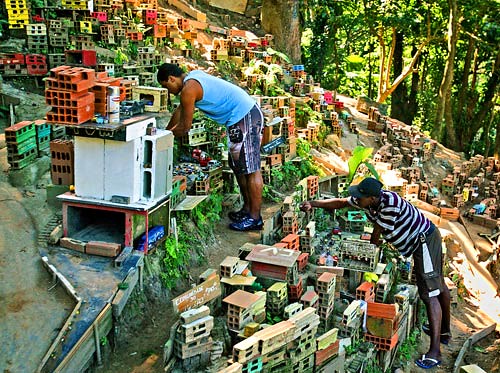
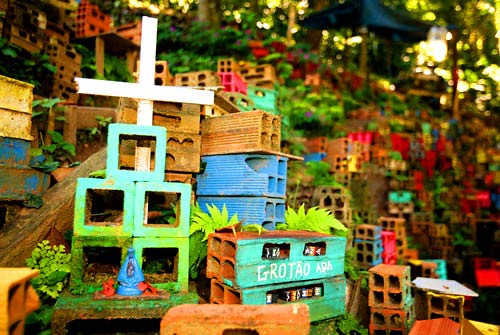
[Images: The Morrinho Project, from the LA Times, From the streets of Brazil, 2007, photo by Wania Corredo.]
I just love how the original replica served as a catalyst for this type of community building, local self-empowering, artistic activity. I wonder how we might all benefit from the same sort of exercise, building replicas of our own communities as a way to engage and examine them more closely. Of course, what's most important is that all of this emerged from within the favela itself, it wasn't airlifted in, designed from the outside, or photoshopped later, or demolished and recreated from scratch. It was recycled, remade, re-imagined out of their own scrap heaps, fancied into their own self-portraits, which gets back to my original thoughts about the shanty being able to tell its own story with its own material, through its own representations. This just seems critical to me - self-representation. I wonder how many stop to consider the autobiographic power of urban salvage this way.
All Images of Dionisio González's work can be found here: 1; 2; 3; 4)
(Spotted at Josh Spear, thanks to Michael!)







20 Comments:
If the artist’s intention was to create strong, provocative images, he has certainly succeeded. But let’s not imagine that they somehow inform the future of slums/favelas/shantytowns.
Conceptually, they stop short of addressing the problematic of how slums/favelas/shantytowns can be transformed from within. The photomontaging process seems to take these complex constructions in the direction of conventional building types, especially 'apartment' buildings. As such, they remain the ‘poor relatives’ of their more affluent cousins. It seems to me that the way to visualize their transformation is in the direction of entirely new types combining new geometries with new solutions to sanitation, security, water, movement, transportation, and communication. A daunting but hopefully doable task. These images have more to say to architects on the outside, than to those within. That is, they are formally interesting, and can be adapted by those who can afford to build as they choose, but contribute little to the efforts of those who can’t.
I want to add that the 'Morrinho project,' created by the children of a favela, is not only poignant, but loaded with the potential for a transformation from within. This is to be nurtured....
Hey Lebbeus,
Thanks for your comments.
I agree with you completely that these pictures shouldn’t be mistaken for somehow informing the future of the slums directly. However, as images of slums, they have an invariable impact on how slums will go on being perceived (“viewed”) from the outside.
(For the record, I think “slum” is a completely disrespectful term, and wish we all could stop using it.)
Nevertheless, I am curious about these images’ potency that way – as visual depictions helping to shape the imaginary geographies of global poverty; this squatter imaginary. I am both inspired by this photomontage and skeptical.
With regards to these images directly engaging the future revisions of these informal settlements themselves, I also agree that we should not imagine (nor would I want to imagine, might I add) that these would have any influence or instructional value in any way – that they would be able to “offer an alternative”. That would be the last thing I’d like to see these images doing, or even trying to do – to be squatter urbanistically didactic.
I hope I did not let on that I thought they were architecturally influential this way, but in saying I think they suggest ‘spaces still to come’, I meant spaces in both the imaginary geographies of how sites of urban global poverty are seen (without ever actually being seen), as well as how they might actually come to look one day, for better or for worse. I do think that some of the images seem like viable subtle blends of modern scraps that aren’t necessarily indicative of some viral gentrification, but merely useful adaptations of modern architectures incorporated into the slums of the slum’s own volition. I think some of these images are positive in this way.
I do see each of Gonzalez’s images addressing different and separate layers of the forces that shape slums, from horrendous gentrification to basic intrinsic recycling ecologies. I appreciate his images for being able to portray a kind of visual archeology of the slums, this way.
But what can, or should, we expect of photographs with regard to providing any kind of solutions? I hope nothing. As soon as I abandon any belief that photos could “help” the squatter condition and see them for what these images are, then I think they are useful as ways of challenging our views of slums, which is just as important to how slums go on being represented as is the actual production of slums speaking for themselves.
This is why I wanted to use them as a launching pad to talk about the Mirrinho Project, ultimately what I see as something that is part of a “solution”, though I am thoroughly convinced “help” and “solution” are not at all the terms we should be using here.
Regardless, the Morrinho Project is about the squatter defining themselves, whereas as I see the Gonzalez photos as a fascinating visual challenge to those on the outside questioning our premises for how we choose and decide to perceive the slum in the first place – essentially, how we project images of poverty, how we need to deconstruct that, how we need to see “slums” for how they are (and should be) represented by themselves.
Anyway, blah blah blah.
I agree with you, the images are more about the architect's vision than a concept for any one else. It's a kind of architectural fantasy and nightmare all in one. Squatters certainly have little need for such constructed portraits of their structures.
This comment has been removed by a blog administrator.
Bryan, I am grateful for your posting of both the Gonzales and Mirrinho images (I was not aware of them before), and for your comments, which are a lot more circumspect than mine.
As someone who has received considerable criticism for ' aestheticizing violence,' I am especially sensitive to the topic. Poverty, we remember, is a form of violence, perpetrated by one group of people on another. My projects for Sarajevo and Havana did aestheticize the violence occuring in those cities--that is, make it look better than it is--and the only justification I could live with was that it would heuristically aid in improving their difficult situations in some better future. Whether that is actually the case remains to be seen.
I don't think we an raise the topic of squatter settlements (i'll accept your rejection of 'slums') without acknowledging the violence of poverty and looking for ways, as architects, to at least mitigate its effects on the people most directly involved. I hope this doesn't come off as a holier-than-thou attitude. The situation is actually quite humbling.
Lebbeus,
Yes, your point about not being able to bring up squatter settlements without acknowledging the violence of poverty is a good one, and thanks for reminding me of that.
It is such a difficult question: how can “we” (on the outside) mitigate/improve/assist/etc. the conditions of not only poverty, but the inherent injustice that is productive of this space in the first place – the violence of poverty?
I might say that architecture is the last place we should begin to look to do this. It would be like trying to cure a systemic problem with a superficial suture.
Because, as it seems to me, the last things squatter settlements need is our building help – it looks like they have done a miraculous job on their own already, if you ask me.
What they do perhaps hope for from the outside is some form of insurance that they are not going to be removed from their land, that they are fixed there with their own entitlements, their own political protection, and will have the right to proceed with building their own communities without the threat of being displaced, or penalized, or further marginalized/restricted from reaches of opportunity. Also, perhaps they want to be seen as human and not demonized as vile byproducts of globalization, or something as they are generally characterized by the western media. In that sense I think we can make a huge impact just in the ways we refer to these communities, in the ways we choose to acknowledge and mention them. Maybe it is our job to make sure we represent them as they would want to represent themselves, not as we want to see them, or have the rest of the world see them. But I am only repeating myself here.
As architects, of course we want to believe that we can make a greater impact than that, but I am not sure yet we can, because I am not sure yet how that engagement should work, what should start it, and more importantly who should take the lead.
My instinct is to let the squatters pioneer this effort where the architect perhaps follow along, and may even learn something himself. Check this other post out: Squatter Mimicry
With regards to your own work, I have always been a huge supporter, and understand the degree of humanism and humanitarian impetus behind what has been perceived as your own aestheticization of violence. I think your sensitivity to this terrain is actually very much in play and your warning here in this context is a point very well taken.
Man, I need to fly back out to NYC so we can keep rapping about this for hours! Get Rob Neuwirth back into the mix, too.
The urban development of informality is probably the most fascinating topic to me in the entire world! I need to do more traveling, get back out there again – see how the squatters are innovating, learn from them what it is they want.
Let's keep talking.
We will keep talking, Bryan, and being active, as you have been here. Thanks.
Lots of provocative things here. Thanks, Bryan, for writing so imaginatively about this. And thanks, Lebbeus, for your frank responses.
I went through many different feelings about Dionisio Gonzalez's photos as I read your post. I was alternately angry at them and happy with them. The problem, I think, is they can be 'read' in different ways, depending on the knowledge and perspective of the viewer. This bothers me. I'm not arguing for didactic, inflexible art. But I also don't like images that are so squishy they wind up being without meaning.
I want to like the artistic project of crashing the favelas and the asfalto (the legal city) together -- particularly as I think this process is actually going on in some places.
But there's something disspiriting here: the crash is all formal. As if pure built form -- the Gehry-like shapes and condo-like structures that Gonzalez photoshops into the favela streetscapes -- is the only point of collision.
The photos made me wonder about process: if Gonzalez is using his own images or if he has scanned and chopped up the images of others. For all the photos I have found on the web present blockfronts: a line of townhouses that all front a straight-arrow street: favela as gridded city. Certainly some favelas are may be like this. But, at least in Rio, from inside the favelas have all the twisty shapes Gehry favors as they slither around the natural outcroppings of the hills on which they are located.
So Gonzalez has not inquired into these communities from inside. He's content to look at them as streetscape (or, in a more negative spin, eye-candy.)
2. The Morrinho Project is, as Lebbeus notes, loaded with potential. It definitely comes from within the favelas. But it, too, risks being aestheticized rather than activized by being hauled into galleries. I'm glad the spirit group of artists have had the chance to exhibit their exuberant sculpture. But I'd love to see them use their undeniable power to work for social change in Rio in addition to reconstituting their creation for foreign audiences.
Thanks for letting me rant on.
What an interesting post and discussion. I saw a couple of these collages at the 2006 Biennale in Venice and found them to be just as slippery in their meaning as rn commented, and just as seductive as your post describes.
There is, in my opinion, something deeply decadent about them. Is it the aestheticization of informal settlements? Or is it the way they're made to conform to "first-world" standards by being untangled and by adding stone, steel, and glass elements?
I finally settled on the idea that they may be a critique of how architects "on the outside" have begun to see and deal with the informal settlements. The prime example of this somewhat superficial fascination with informal settlements as some sort of self-generating and self-regulating environment remains, for me, the Harvard Project on the City's look at Lagos. The way that report seeks to simplify and aestheticize Lagos seems to have something in common with the collages we see here.
For me, what the artist is saying amounts to, "When you talk about the slums, this distorted vision is what some of you see. And it's what the rest apparently wants to create. WAKE UP. You are all writing postcards from a place that only exists in a composite photograph."
That's just my two cents, but I think they're meant to be aesthetically seductive and conceptually decadent and disturbing at the same time. A well-deserved slap in the face for, say, people who might look at the Morrinho Project as a charming bit of folk art.
Again, very thought-provoking post!
I could not agree more with the last two comments.
The issue of exploitation is lurking beneath the unease some of us feel with the images. Not just commericial exploitation, but the intellectual and artistic gain to be had from appropriating the not-so-good circumstances of people we don't know and do little to help. There's no neutral ground here. Either we're helping or hurting. If the Gonzales images help the circumstances of those who live in the favela, I'm having a hard time understanding how.
Clean, big, wide and clear surfaces are expensive!
Check the brasilian participation to the documenta in Kassel.
Is there an idyllic component to slums/favelas? Not very exciting!
I wonder if – at all – the aestheticization of the favela is even avoidable. This may sound ridiculous, but just in bringing them up, trying to talk about them from the outside, are we being somehow inherently exploitative, perhaps without even meaning to be, for the purposes of our own conceptual progress?
I don’t know. I find this utterly complex, like how do we refer to the favela without stumbling into our own unconscious exploitation of it in some way?
Would we have rather Gonzalez be more obvious about his conceptual exploits? More upfront, instead of ambiguously referring to them, as Rob described?
Again, each of these images seems to me to wrestle with expressing vastly different angles, but in their totality I guess they amount to ambivalence and abstractness, since – again, as Rob states – they require some pre-knowledge on the viewer’s part to really make any sense.
But how do we even begin to approach any kind of conversation or portrayal of the favelas while making sure to avoid any exploitation of it? Is it possible?
If these images are not helping the circumstances of the favela dwellers themselves, does that have to be a negative thing?
I certainly have no answers, but only want to pose more questions?
How can we refer to poverty without actually engaging it?
Do we have the right to propose anything if we have not experienced it ourselves, or have not involved those who have?
Bryan, it IS unavoidable to exploit. Do medical researchers exploit the suffering of cancer victims, or AIDS victims, when they advertise to get funding to find a cure? Of course they do. With the money they raise, they enhance their personal careers, pay their own salaries, as well as--hopefully-- contribute to medical knowledge and practice. The question is not whether they exploit, but whether, in doing so, the 'good' they do outweighs the 'bad.' At some point it's a measurable distinction; but until that point, it's a judgment call each of us has to make.
In a way, Lebbeus is right.
Let's be honest: would we be paying this much attention to Dionisio Gonzalez's photos if he had photoshopped fancy highrise digs and curved shapes into suburban cul-de-sacs?
If we only present favelas as pockets of poverty, or zones of crime, or sites of social pathology--in short, if we tag them as radically other--we misrepresent them.
Still, I continue to hope that there is a possibility of non-exploitative representation. It happens when art opens us all (the artist, the audience and the community involved) to a space where we can see beyond our own preconceptions and prejudices. A space where we can be surprised by what we realize about ourselves and our relation to the rest of the world.
I fully accept the inherent exploitative nature of the artist here, and to Lebbeus’ point – the same exploitative nature in human engagement in general.
Lebbeus, how do we measure the ‘good’ impact versus the ‘bad’, what is the criterion we should use for this? Or, by what standards…? I agree – to some extent – that it is subjective and a decision everyone must weigh for themselves, but I am asking you personally: how would you as an architect or artist engage the context of ‘slum representation’ that would outweigh the intrinsic exploitative implications of that? You mentioned at Postopolis! that you were working on this, and “had some ideas”, and I would be very curious to hear more.
One other layer I find so intriguing is my own inability to resist this context in the first place. And I wonder, why I am so damned obsessed with squatter settlements, what draws me in, towards my own fascination with imaginaries of ‘the other’, my own human spirit to try and want to “help”? Or is it really just my shallow obsession with images and representations themselves that fail to go beyond any real value? Forgive my clumsy self-reflexivity here, but – why am I so helplessly glomming onto to this subject in the first place?
Also, I wonder where all of this leaves the outsider architect in this context who wants to contribute in some idealistic way to the favelas’ progress? How does that person value their own contribution, where do they begin, through what process can the design community respectfully consider and contribute to any sort of positive impact to be made there?
Rob, yes, I, too, want to believe in the possibility of a just representation; the ability for art to engage this context perhaps not non-exploitatively (if I accept that that prospect is unavoidable) but somehow post-exploitatively in a way that gives something back more than it has taken or usurped in its reference to poverty along the way, simultaneously. Not sure if that made much sense, but if we must accept that to engage this context is a form of unavoidable exploitation of it, then what measurement of contribution must we use to outweigh, as Lebbeus says, the bad with the good? I like your description of how art must open all parties involved to some higher more universal or transcendent form of reflection, but that is also so abstract.
I don’t know. In fact, I obviously don’t know squat (no exploitative pun intended), but just trying to understand the cognitive relativity of all this, the reflective value in hindsight, the things to consider in my own assertions about representing poverty and other similar contexts.
It’s a heavy thick sticky molasses, to be sure. Safe is to say, I am stuck here on where to stand in my own approach to contributing thoughts and efforts towards any kind of representational favela justice.
Bryan, I am moving along in my response to squatter communities and how to improve their unacceptable, often desperate living conditions. I will publish--on the internet first--when I feel that I have something that might do some good.
As for my personal judgment call on whether the good outweighs the bad in any exploitation of such conditions, I would say that 'consciousness-raising' is not good enough. Thinking that even photos of starving children and filthy living conditions are going to be a revelation to anyone, motivating them to action, is, as they say, disingenuous--we've been seeing those photos for years.
In my view, the good that remains to be done is to find a way forward in improving the conditions--new ideas, new strategies, new techniques. We clearly need fresh approaches, however far out they may seem at the outset. There is plenty of room for artistic and design innovation, and we should encourage experimentation, even if it doesn't lead to some grand solution.
The Gonzalez photos sanitize (improve) the conditions (no starving, no filth) but in a post-modern, purely imagistic way. It's pretty clear that there is no idea, or aspiration, for actual improvement.
Therefore, my judgment call is: thumbs down.
12 th. picture from the top reminds me the section of venice boardwalk, the more affluent so. of venice blvd. portion that is. i am sure there are many more boardwalk/contemporary condo-loft three story conditions elsewhere. they can hardly be the aspiration for improvement of slums. the question is;
will the lifes of slums be better when they imitate the lifes of rich and famous with expansive glazing and modern furniture? how can a model like that actually bring a sustainable improvement to slums? even with the impossibility of the financial end of it taken care of by the brad pitt donations let's say.
maybe the artist was naive that the gentrification of the slums were a visual possibility he/she was suggesting, without wanting perhaps. i agree, the grid and strip is not real. even it is, the within is hollow. i don't find realistic or substancially helpful that the natural improvement of the so called slums are to arrive or triumph with that kind of glass and aluminum architecture, which i guarantee will be on its way out once it is decided by some chic media it is no longer fashionable and don't match with new shoe fashions, or something like that.
since i don't know the artist, could this be an irony piece in which artist is relaying the odsurdity of all the bourgeoisie attention given to the slummed lives? why the hell ivy students are leading the studies in slum conditions anyway? guilt free diplomas? this work would be good if the show followed by a burning of a full scale mock up of one of the designs used in the renderings.
sorry for butting into this so late.
This comment has been removed by the author.
Hi, I Stumbled into this blog by accident and I'm not sure if this link works but I made a drawing once on the topic. It's called: " Slums awakening to larger interests":
sandrosetola.com/images/022slumstext_000.jpg
I think it demonstrates most people's inability to think out of the aesthetical book in solving social problems (unlike Lebbeus Woods whom I greatly admire for doing so). Ironically though, or should I say naturally It's one of the few drawings I ever sold. Ha! The aesthetics of suffering seem to be very commercially viable... Mr. Gonzalez just made more profit out of it by doing a series! greetings and thanks for new inspiration!
Sandro
The photographs of the slums are beautiful! Why is it that urban decay is so well represented in a photo? I am in no way advocating the non development of these living spaces!
Post a Comment
<< Home